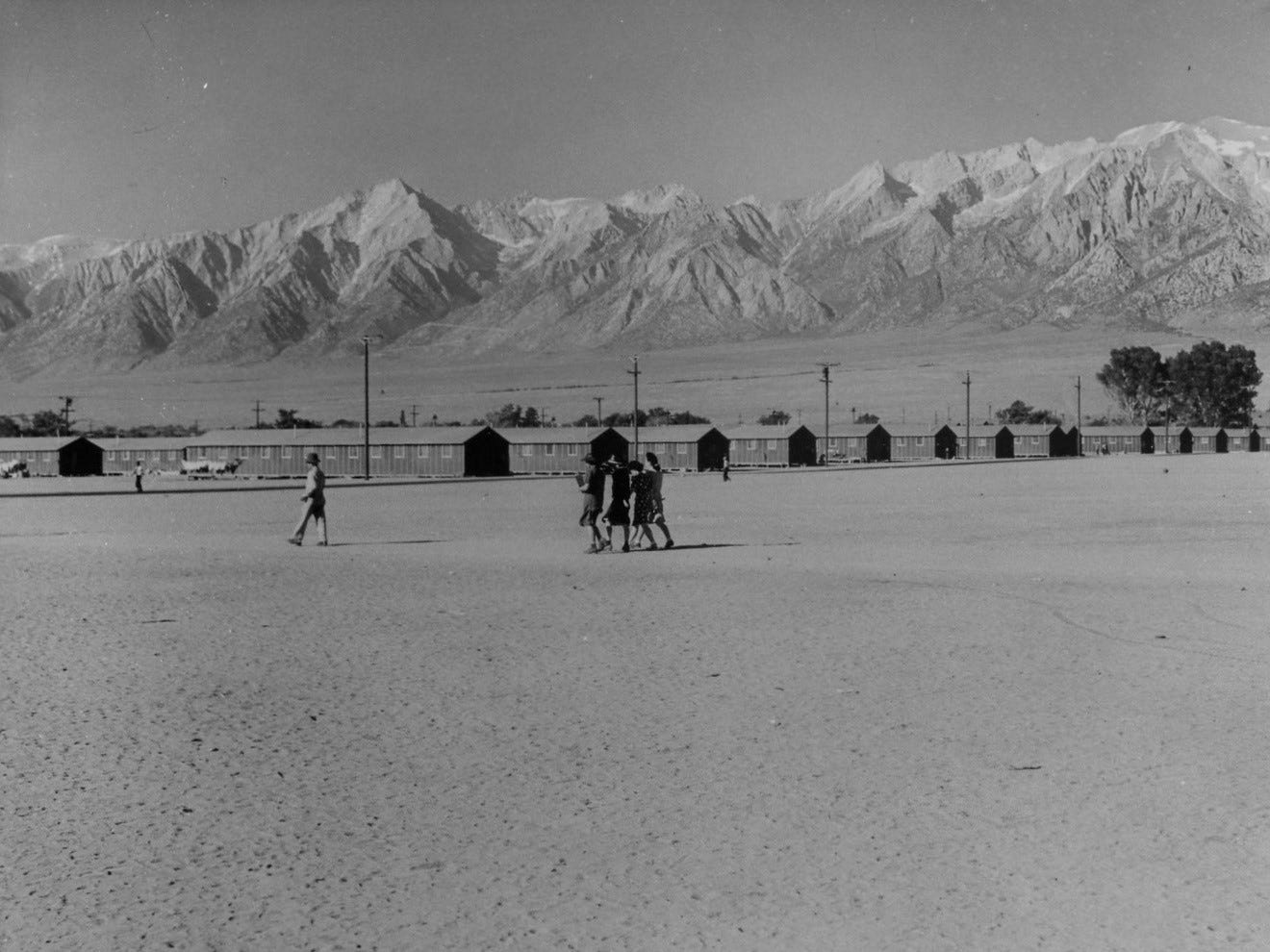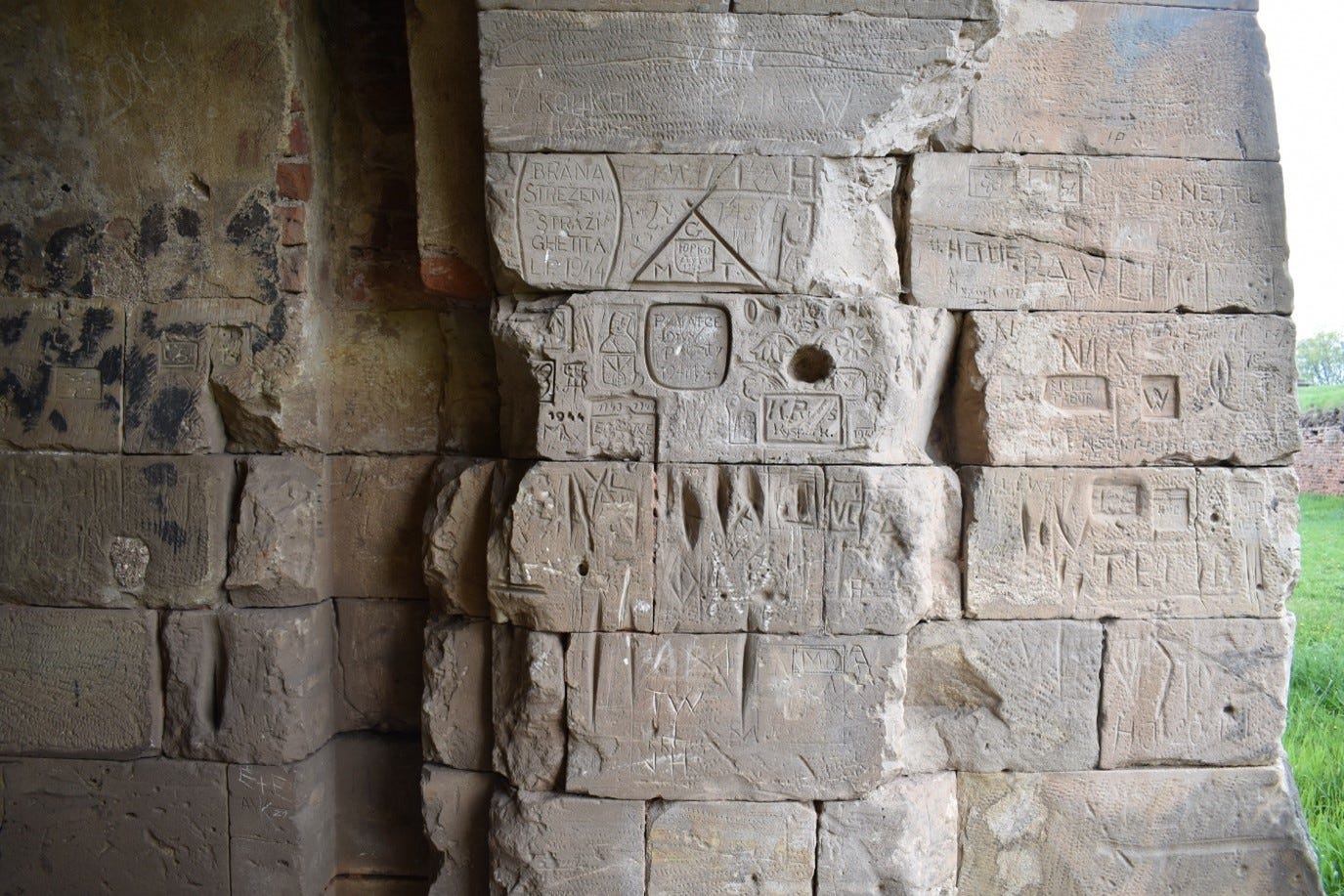When I bring up historic graffiti, what do you think of? Is the first thing that springs to mind Pompeii, with its raunchy writings and declarations of love?[1] Or perhaps you go back further, taking cave paintings as the first instance of graffiti, hands and animals imprinted on the walls. Maybe the Tower of London pops into your head, its messages from imprisoned heroes and traitors now protected under Plexiglas.[2] Perhaps you are a Shakespeare fan, admiring visitors’ names etched into the glass windows, among them Mark Twain and Thomas Hardy.[3] What all of these famous instances of graffiti have in common is that they are from a more distant past, representing people we can no longer reach, a world that is long gone. But what about modern graffiti?
When I say modern graffiti, I mean from the past 100 years or so, a more recent past, one that is still in living memory, if just barely. Graffiti has never ceased to exist. While older graffiti is admired as a window into the past, modern graffiti is mostly seen as a form of vandalism that needs to be eradicated. But because it exists on the margins, as a taboo, graffiti can express fringe ideas and identities, giving voice to people who would otherwise not be able to leave a resounding legacy.
During the Second World War, graffiti proliferated. A famous example is ‘Kilroy was here’, known as ‘Mr Chad’ in the UK. He was a cartoonish bald man peeking over a wall, his pendulous nose hanging over the side. A sign that Allied troops had already been there, graffiti depicting Kilroy boosted morale and broke the tension of awaiting battle. Kilroy has become a famous symbol of the Allied troops, but less well known is graffiti from internment camps and concentration camps.
The Manzanar Japanese-American Internment Camp during the Second World War. Public Domain. Credit: Dorothea Lange Gallery, Manzanar National Historic Site, US National Parks Service. (For more photos of Manzanar, I suggest looking at the work of Toyo Miyatake, a survivor of Manzanar and its secret photographer.)
In the United States, Japanese-American internment camps remain a source of national shame. Prior to the war, in anticipation of conflict with Japan, U.S. intelligence agencies had been conducting surveillance operations in Japanese American communities, convinced that they were not loyal to the United States. After the bombing of Pearl Harbor, community leaders who had been under surveillance were swiftly detained. Two months after the attack on Pearl Harbor, President Roosevelt signed an executive order that allowed for the removal of anyone deemed to pose a threat, paving the way for the Wartime Civil Control Administration to round up over 100,000 Japanese Americans living on the west coast and send them inland to internment camps, surrounded by barbed wire and watch towers. When the internees arrived at these sites, they were often incomplete, having been hastily erected in remote regions. The internees were put to work building, creating traffic circles, and digging ditches. The construction provided many opportunities for graffiti writing, from poems about ‘ugly, despicable Americans’ to self-deprecating jokes:
One former internee, George Izumi, related the story that he and two other kids found a retaining wall with wet concrete at the chicken farm, and inscribed their names. Izumi had a broken leg at the time, and jokingly signed himself as Gimp.[4]
Though a formal apology was finally issued by the Reagan administration 43 years after the final closure of the camps, the Japanese-American internment camps are little discussed and memorialised, and their history is not widely known. Initiatives to change raise awareness are underway, and these graffiti are an excellent step in sharing the history of the sites and encouraging tourism to them.
Graffiti in a gateway of the Theresienstadt Ghetto, Czechia. Credit: Jennifer Putnam. (For more on the graffiti at Theresienstadt, see here.)
Better known is the incarceration of prisoners of war, political prisoners, ostensible ‘criminals’, Jews, and Roma and Sinti under the Third Reich. The Nazi concentration camps and ghettos, though part of one of the most oppressive carceral systems in history, were filled with graffiti. It is perhaps because these sites were so oppressive that graffiti proliferated; the fear of ‘disappearing’ and leaving no traces behind for one’s family motivated prisoners to make their mark, to leave a trace of their arrest, deportation, and possible execution so that someday, they could be found. Survivor Kitty Hart-Moxon testified that graffiti was imperative to communicating with one another:
Mostly you left your name and your [prisoner] number so that if somebody came in and they saw your name, then […] they knew that you’d been there. Yea, so that is the only way to communicate in a way because there was no other way you could communicate and perhaps the – your family’s there and your friends and they needed to know where you were, so it was an important message, if you could do it.[5]
Kitty knew the risks and chose to leave messages for her friends and family anyways: ‘I was once caught and got 25 strokes. […] It didn’t discourage us, I assure you.’[6] But the graffiti wasn’t just about finding each other. There is graffiti of everything: birds, letters, portraits, houses, poems, laments about bed bugs, swears, even a giant painting of Mickey Mouse. Graffiti was made to depict what people missed, what they longed for, what they were upset about. They were expressions of frustration, resistance, efforts to make the rooms beautiful, and paintings to distract the children in their care.
Faded painting of Mickey Mouse in an attic that was formerly a nursery in Theresienstadt Ghetto, Czechia. Credit: Jennifer Putnam.
Last year, I was explaining my research to a friend of a friend over a pint. He asked, as most people do, what the graffiti said. It says everything, I told him, from people’s names and the places they had been to depictions of animals, drawings of loved ones, even carvings of genitalia. He perked up at this last mention, now interested in what had seemed like serious work but now appeared to be silly. I explained that sexual graffiti has always been around. Famously the graffiti in Pompeii is full of genitalia, even a large penis pointing customers to the brothel. Laughing, he said, ‘I feel so connected to humanity right now.’ The more we learn about the past, the more we see that we are all connected, across times and places. People have always been people and will always be people: silly, serious, fleeting.
References and Resources:
Adrienne, LaFrance, ‘The Graffiti at Pompeii and the Ancient Origins of Social Media’ The Atlantic (29 March 2016)
Mysteries of historical graffiti | National Trust
Hidden Graffiti in English Heritage Mansion Reveals Secrets of Polish War Heroes | English Heritage
Joseph P. Czarnecki, Last Traces: The Lost Art of Auschwitz (1989)
Peter Hobbins, Ursula K. Frederick, and Anne Clarke, Stories from the Sandstone (2016)
Emma Bryning, Charlie Kendall, Megan Leyland, Tyson Mitman, and John Schofield, ‘Fame and recognition in historic and contemporary graffiti: examples from New York City (US), Richmond Castle, and Bristol (UK)’, World Archaeology 3 (2021), 435–450.
Eleanor Conlin Casella, ‘Enmeshed inscriptions: Reading the graffiti of Australia’s convict past’, Australian Archaeology 1 (2014), 108–112.
Polly, Lohmann, ‘Historical Graffiti: The State of the Art’, Journal of Early Modern Studies 9 (2020), 37–56.
Katherine Reed, ‘“Charcoal scribblings of the most rascally character”: conflict, identity, and testimony in American Civil War graffiti’, American Nineteenth Century History 2 (2015), 111–127.
Jennifer Putnam is a historian and linguist. She is currently a Conny Kristel Fellow with the European Holocaust Infrastructure. Jennifer submitted her PhD thesis on graffiti in Nazi concentration camps and ghettos at Birkbeck College, University of London in August 2023. Her most recent article is entitled ‘The Struggle Against Timelessness: Prisoner Experiences of Time in Nazi Concentration Camps and Ghettos’.
[1] Sarah Levin-Richardson, ‘Facilis hic futuit: Graffiti and Masculinity in Pompeii’s “Purpose-Built” Brothel’, HELIOS 1 (2011), 59–78.
[2] Ruth Ahnert, ‘Writing in the Tower of London during the Reformation, ca. 1530–1558’, Huntington Library Quarterly 72 (2009), 168–192.
[3] Juliet Fleming, ‘Wounded Walls: Graffiti, Grammatology, and the Age of Shakespeare’, Criticism 39 (1997), 1–30.
[4] Jeffery F. Burton and Mary M. Farrell, ‘“Life in Manzanar Where There Is a Spring Breeze”: Graffiti at a World War II Japanese American Internment Camp’, in Harold Mytum and GiGilly Carr (eds.), Prisoners of War: Archaeology, Memory, and Heritage of 19th-and 20th-Century Mass Internment (2013), 249–250.
[5] Kitty Hart-Moxon and Peter Hart, personal communication, 26 March 2021.
[6] Ibid.







